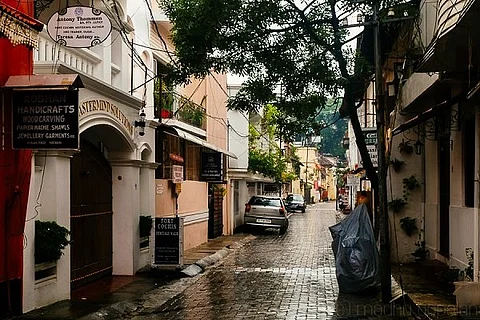

On the shores of modern Kochi (or Cochin), lies a picture-perfect seaside neighborhood called Fort Kochi. Its delightful cobblestoned lanes filled with influences from different parts of the world hint at a long, eventful history that began with Kerala’s flourishing spice trade.
It is believed that the coast of Kerala was an important center of spice trade since at least 3000 BC, and had commercial links with important kingdoms in West Asia and beyond. Spices from the region were in great demand, and even the ancient Egyptians are said to have used cinnamon from Kerala to embalm the bodies of deceased royals.
Until the year 1341, Kodungallur, 30km to the north of Kochi, known as Muziris back then, was a major port for spice trade on the Malabar Coast. A devastating flood in the Periyar river closed up the port permanently, but bizarrely, it created a new natural harbour in Kochi. All trade then shifted from Muziris to Kochi, and the obscure town suddenly came into prominence.
A spice warehouse on Bazaar Road, Mattancherry
In 1497, the famous Portuguese explorer Vasco da Gama, made his way from Portugal to the Malabar coast, via a maritime route, paving the way for the Portuguese to establish a base in India, and control spice trade in the region. With the permission of the Raja of Kochi, they first set up a trading post, and then a small fort called Fort Kochi, giving the place its name. In the year 1503, they built the St. Francis Church, the first European church in India. Vasco da Gama, who visited India thrice during his lifetime, died in Fort Kochi during his third visit, and was buried in the church. A few years later, his remains were taken back to Portugal.
The site where Vasco da Gama was originally buried
In the 17th century, the Dutch snatched Fort Kochi from the Portuguese after a siege and made it a part of their territories on the west coast, collectively known as the Dutch Malabar. They controlled Kochi for about a century, and then ceded it to the British. After independence, the princely state of Kochi joined the Indian Union.
Santa Cruz Basilica, first built by the Portuguese, later rebuilt by the British
A school now runs in this warehouse built in the early 19th century
Kochi also has a rich Jewish legacy, which lingers on in the Mattancherry neighborhood adjacent to Fort Kochi. In the past, the region had a sizeable population of Jews. There were the Malabar Jews, who claimed descent from King Solomon of Israel, and later, the Sephardic Jews, who migrated from the Iberian peninsula after edicts in their kingdoms decreed that Jews living there must embrace Catholicism, or leave.
Some of them migrated to the Malabar coast. They were white skinned, and were known locally as Paradesi Jews; paradesi/pardesi means foreigner. In 1567, the Sephardic Jews built the Paradesi Synagogue on land granted to them by the Raja of Kochi.
The Paradesi Synagogue in Mattancherry
A Hebrew greeting on a signboard in Jew Town
Kochi’s most famous foreign influence, however, would have to be the Chinese Fishing Nets. These are cantilevered fishing nets that are lowered into the sea to trap fish, crabs,etc, and then raised to collect the catch. It is said that these were introduced to the Malabar coast by Chinese travelers who came from the court of Kublai Khan in the 13th century.
Chinese fishing nets on the Fort Kochi seashore
The greenery filled streets of present day Fort Kochi and Mattancherry are lined with colonial mansions, heritage hotels, beautiful churches, trendy cafes, quirky boutiques, colorful graffiti, art galleries, antique shops, old cemeteries and fragrant spice markets; just perfect for a relaxed stroll into the past, with a piece of history at every corner.
All photographs by Madhumita Gopalan